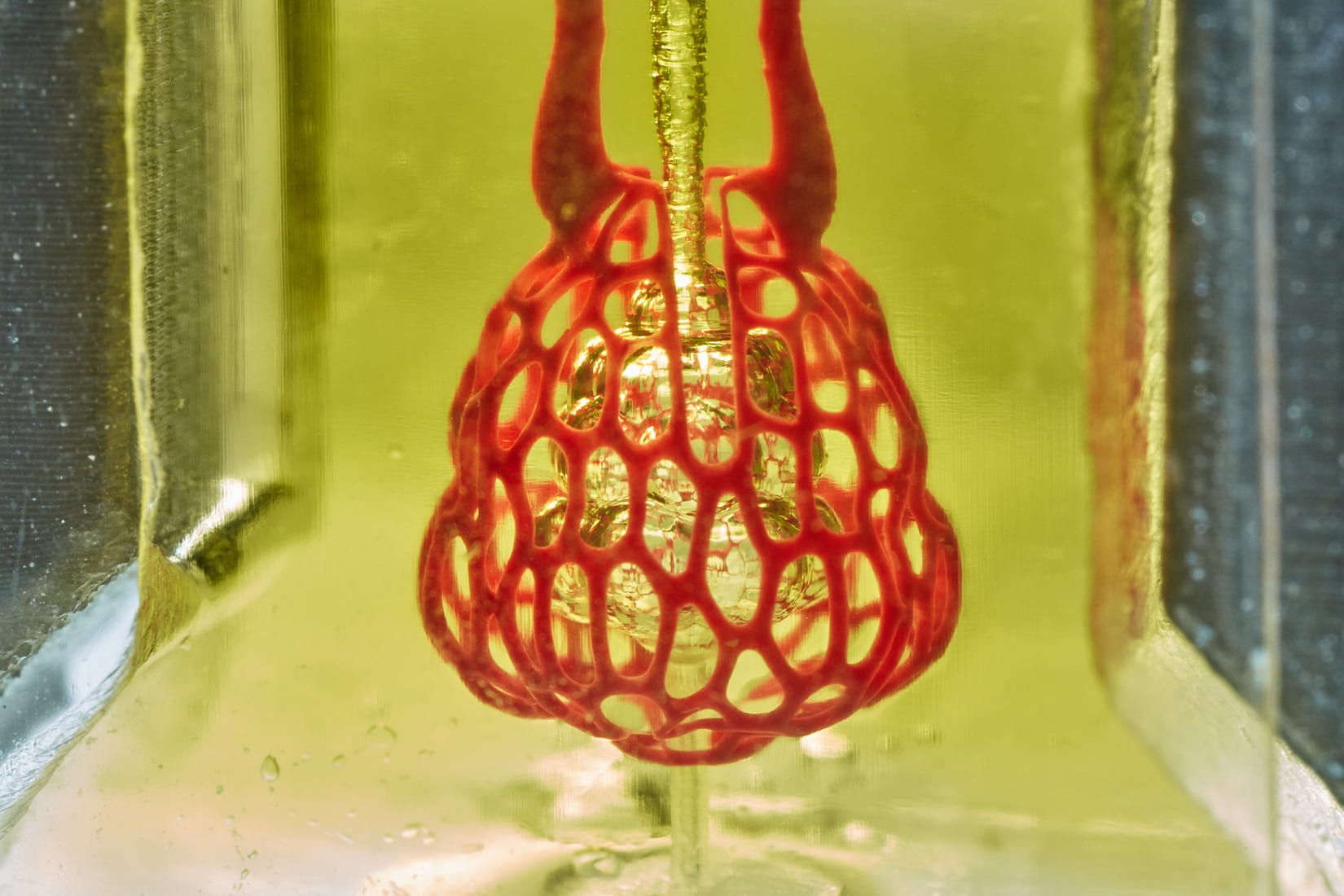
Scientists have come a step closer to creating working 3D-printed organs, using food dye to create a tangled network of vessels that resemble those populating the human body.
The team used hydrogel, a polymer gel, to print an air sac that mimics a human lung, sending oxygen to blood cells in nearby vessels. The fake lung was able to pulsate without splitting open.
The team's work, published in the journal Science and also featured on its front cover, showed that smaller structures in the body, like intravascular valves found in the heart and legs, could be printed. Another experiment saw the bioengineers implant mice with bioprinted structures containing liver cells, which were strong enough to survive the process.
Study co-author Kelly Stevens, an assistant professor at the University of Washington who runs a lab investigating printing human tissue from stem cells, explained to Newsweek, "The body contains various networks of 'pipes' that bring nutrients to, and remove waste from, the organs in our body.
"Many of these pipe networks in the body are entangled, so they have been very hard for scientists to replicate by 3D printing. This new method allows us to create multiple entangled networks of pipes in 3D-printed tissues.
"We were surprised to see how structurally complex of features we could print with this new method."
Projection stereolithography, a method of 3D printing which uses light and photoreactive resins to produce objects, was at the center of the work.
The team called the new technology stereolithography apparatus for tissue engineering, or SLATE. It prints hydrogels into tissue-like structures layer by layer. The liquid hydrogel solidified when it came into contact with blue light, which was absorbed with the help of food dye.
One day, the team hopes, 3D-printed tissue will help chip away at the organ donor waiting list, which currently consists of more than 100,000 people in the U.S. alone.
Dr. Jordan Miller, study co-author and assistant professor of bioengineering at Rice University's Brown School of Engineering, explained in a statement: "With the addition of multivascular and intravascular structure, we're introducing an extensive set of design freedoms for engineering living tissue.
"We now have the freedom to build many of the intricate structures found in the body."
Stevens said in a statement: "With this work, we can now better ask, 'If we can print tissues that look and now even breathe more like the healthy tissues in our bodies, will they also then functionally behave more like those tissues?'
"This is an important question, because how well a bioprinted tissue functions will affect how successful it will be as a therapy."
Stevens said the liver was a particularly interesting organ to investigate, as it has 500 functions and is likely the busiest organ other than the brain.
"The liver's complexity means there is currently no machine or therapy that can replace all its functions when it fails. Bioprinted human organs might someday supply that therapy."
But the team is a ways away from seeing its technology used to print human organs.
Stevens told Newsweek: "Our smallest features are still around 0.3 mm [0.013 inches] in diameter. That is still two orders of magnitude larger than the size of a typical cell in the body. So we'd like to continue improving our patterning resolution. We think this is possible with continued innovations in both the printing method and materials.
"We hope that we can ultimately build 3D-printed human organs that could be used as a bridge or replacement to organ transplantation. That is a lofty goal, and we still have work to do before we get there. But at this point we are more optimistic than ever that this is a possibility."
Bing Hu, an associate professor in oral and dental health research at the University of Plymouth, told Newsweek: "This study shows significant progress in printable synthetic biomaterials, because a major limit at the moment for the 3D bio-printing field is the hydrogel being able to integrate different cell types—particularly endothelial cells, those that line the interior surface of blood vessels.
"The materials and techniques developed in the study provide novel possibilities for strategy designing on tissue/organ regeneration, particularly due to the vascular-like structures that formed into the materials. I am keen to see the reported technologies applied in craniofacial research fields such as salivary gland and tooth regeneration."
Uncommon Knowledge
Newsweek is committed to challenging conventional wisdom and finding connections in the search for common ground.
Newsweek is committed to challenging conventional wisdom and finding connections in the search for common ground.
About the writer
Kashmira Gander is Deputy Science Editor at Newsweek. Her interests include health, gender, LGBTQIA+ issues, human rights, subcultures, music, and lifestyle. Her ... Read more
To read how Newsweek uses AI as a newsroom tool, Click here.








